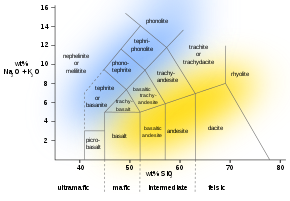Extrusive rock


Extrusive rockrefers to the mode ofigneousvolcanic rockformation in which hotmagmafrom inside theEarthflows out (extrudes) onto the surface aslavaor explodes violently into theatmosphereto fall back aspyroclasticsortuff.[1]In contrast,intrusive rockrefers to rocks formed by magma which cools below the surface.[2]
The main effect of extrusion is that the magma can cool much more quickly in the open air or underseawater,and there is little time for the growth ofcrystals.[3]Sometimes, a residual portion of thematrixfails tocrystallizeat all, instead becoming a natural glass likeobsidian.
If the magma contains abundantvolatile componentswhich are released as free gas, then it may cool with large or small vesicles (bubble-shaped cavities) such as inpumice,scoria,orvesicularbasalt.Other examples of extrusive rocks arerhyoliteandandesite.
Texture
[edit]The texture of extrusive rocks is characterized by fine-grained crystals indistinguishable to the human eye, described asaphantic.Crystals in aphantic rocks are small in size due to their rapid formation during eruption.[3]Any larger crystals visible to the human eye, calledphenocrysts,form earlier while slowly cooling in the magma reservoir.[4]When igneous rocks contain two distinct grain sizes, the texture isporphyritic,and the finer crystals are called thegroundmass.[3]The extrusive rocks scoria and pumice have a vesicular, bubble-like, texture due to the presence of vapor bubbles trapped in the magma.[5]
Extrusive bodies and rock types
[edit]Shield volcanoesare large, slow forming volcanoes[6]that erupt fluid basaltic magma that cools to form the extrusive rockbasalt.Basalt is composed of minerals readily available in the planet's crust, includingfeldsparsandpyroxenes.[2]
Fissure volcanoes pour out low viscosity basaltic magma fromfissure ventsto form the extrusive rock basalt.[2]
Composite orstratovolcanoesoften have andesitic magma and typically form the extrusive rock andesite. Andesitic magma is composed of many gases and meltedmantlerocks.[2]
Cinderor scoria cones violently expel lava with high gas content,[2]and due to the vapor bubbles in thismaficlava, the extrusive basalt scoria is formed.[6]
Lava domesare formed by high viscosity lava that piles up, forming a dome shape. Domes typically solidify to form the rich in silica extrusive rockobsidianand sometimesdacitedomes form the extrusive rock dacite, like in the case ofMount St. Helens.[2]
Calderasare volcanic depressions formed after an erupted volcano collapses. Resurgent calderas can refill with an eruption of rhyolitic magma to form the extrusive rock rhyolite like theYellowstone Caldera.[2]
Submarine volcanoeserupt on the ocean floor and produce the extrusive rock pumice.[2]Pumice is a light-weight glass with a vesicular texture that differs from scoria in its silicic composition and therefore floats.[5]
See also
[edit]References
[edit]- ^"Extrusive rock - geology".Retrieved21 October2018.
- ^abcdefghJain, Sreepat (2014).Fundamentals of Physical Geology.New Delhi, India: Springer.ISBN9788132215394.
- ^abcWinter, John DuNann (2001).An Introduction to Igneous and Metamorphic Petrology.Upper Saddle River, New Jersey: Prentice-Hall.ISBN0132403420.
- ^Schmincke, Hans-Ulrich (2004).Volcanism.New York City, New York: Springer-Verlag.ISBN3540436502.
- ^abNémeth, Károly, Martin, Ulrike (2007).Practical Volcanology: Lecture Notes for Understanding Volcanic Rocks from Field Based Studies.Geological Institute of Hungary.
{{cite book}}:CS1 maint: multiple names: authors list (link) - ^abSen, Gautam (2014).Petrology: Principles and Practice.Berlin: Springer.ISBN9783642388002.OCLC864593152.
External links
[edit]

